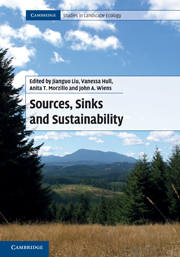Book contents
- Frontmatter
- Contents
- Contributors
- Preface
- Acknowledgments
- Part I Introduction
- Part II Advances in source–sink theory
- 2 Evolution in source–sink environments: implications for niche conservatism
- 3 Source–sink dynamics emerging from unstable ideal free habitat selection
- 4 Sources and sinks in the evolution and persistence of mutualisms
- 5 Effects of climate change on dynamics and stability of multiregional populations
- 6 Habitat quality, niche breadth, temporal stochasticity, and the persistence of populations in heterogeneous landscapes
- 7 When sinks rescue sources in dynamic environments
- 8 Sinks, sustainability, and conservation incentives
- Part III Progress in source–sink methodology
- Part IV Improvement of source–sink management
- Part V Synthesis
- Index
- References
6 - Habitat quality, niche breadth, temporal stochasticity, and the persistence of populations in heterogeneous landscapes
Published online by Cambridge University Press: 05 July 2011
- Frontmatter
- Contents
- Contributors
- Preface
- Acknowledgments
- Part I Introduction
- Part II Advances in source–sink theory
- 2 Evolution in source–sink environments: implications for niche conservatism
- 3 Source–sink dynamics emerging from unstable ideal free habitat selection
- 4 Sources and sinks in the evolution and persistence of mutualisms
- 5 Effects of climate change on dynamics and stability of multiregional populations
- 6 Habitat quality, niche breadth, temporal stochasticity, and the persistence of populations in heterogeneous landscapes
- 7 When sinks rescue sources in dynamic environments
- 8 Sinks, sustainability, and conservation incentives
- Part III Progress in source–sink methodology
- Part IV Improvement of source–sink management
- Part V Synthesis
- Index
- References
Summary
Spatial heterogeneity in habitat quality creates variation in demographic performance among subpopulations and results in source–sink dynamics. We extend this idea to explore the effects of within-patch heterogeneity on population persistence in a simulation model. Spatial heterogeneity, niche breadth, and temporal stochasticity in the environment are widely recognized as important drivers of population structure, yet few studies have examined the combined influence of these factors. Simulated populations had life-history traits resembling perennial forest herbaceous plants, and simulated landscapes were based on forests of the southern Appalachian Mountains. Habitat quality varied continuously within and between habitat patches using realistic patterns based on topographic gradients. Temporal stochasticity in survival was implemented to simulate interannual climatic variation, and levels of stochasticity were varied to reflect different frequencies of extreme events. The effects of habitat fragmentation, spatial variation in habitat quality, and niche breadth resulted in differential demographic performance among habitat patches of similar size and shape. These effects overshadowed the influences of temporal stochasticity on population persistence. The results suggest that populations of forest perennials may be more sensitive to habitat fragmentation and variation in habitat quality than to temporal stochasticity due to climate. Specialist species will be more sensitive than generalists to such changes.
- Type
- Chapter
- Information
- Sources, Sinks and Sustainability , pp. 115 - 138Publisher: Cambridge University PressPrint publication year: 2011
References
- 6
- Cited by

